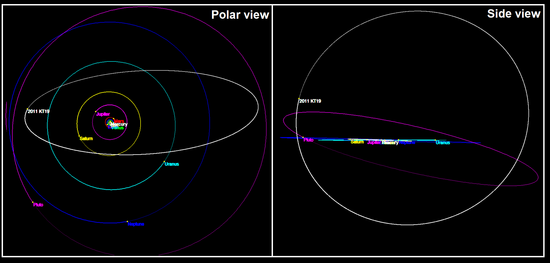|
471325 Taowu
471325 Taowu (provisional designation 2011 KT19, formerly nicknamed Niku (/niːkuː/)) is a trans-Neptunian object whose orbit is tilted 110° with respect to the planets' orbital plane. Thus, it has a nearly polar retrograde orbit around the Sun.[5] DiscoveryTaowu was discovered on 31 May 2011 by the Mount Lemmon Survey in Arizona. It was announced by the Minor Planet Center on 2 June 2011, after other telescopes confirmed the object with additional observations.[6] The object was given the minor planet provisional designation 2011 KT19, which reflects its discovery date.[6] Initial calculations of Taowu's orbit using these few observations suggested it was a centaur on a prograde elliptical orbit (semi-major axis 28 AU, eccentricity 0.41, inclination 38°).[6][5]: 2 However, Taowu was only observed for up to 8 days before being lost, due to large uncertainties in its orbit.[5]: 2 In 2016, a team of astronomers led by Ying-Tung Chen performed a search for outer Solar System objects in observations by the Pan-STARRS 1 survey.[7][5]: 1 They rediscovered Taowu in Pan-STARRS observations from 2013–2016 and recognized it had an unusual retrograde polar orbit. Chen's team made follow-up observations at Lulin Observatory in Taiwan and then found additional observations of the object in archival Dark Energy Survey and Canada–France–Hawaii Telescope imagery.[5]: 2 After Chen's team submitted their observations of Taowu to the Minor Planet Center, it was recognized that Taowu had been previously observed by the Mount Lemmon Survey in 2011.[5]: 2 Once Taowu was given its permanent minor planet number in 2016, the Minor Planet Center declared that Mount Lemmon Survey was the official discoverer. NameThe object is named after Taowu, one of the Four Perils in Chinese mythology. The name was announced by the International Astronomical Union on 3 February 2025.[8] The object was nicknamed "Niku" in 2016 by Ying-Tung Chen, who was involved with rediscovering the object and studying its orbit. The nickname comes from the Chinese adjective meaning "rebellious", in reference to its unusual retrograde orbit.[7] OrbitTaowu is in a 7:9 resonance with Neptune. Currently it is the only object with a nearly polar orbit that is in resonance with a planet.[9] Notably, it is part of a group of objects that orbit the Sun in a highly inclined orbit; the reasons for this unusual orbit are unknown as of August 2016.[5] Taowu's orbital characteristics have been compared to those of 2008 KV42 (nicknamed "Drac"). The orbits of Taowu, 2008 KV42, 2002 XU93, 2010 WG9, 2007 BP102, 2011 MM4, appear to occupy a common plane, with three in prograde and three in retrograde orbits. The probability of this alignment occurring by chance is 0.016%. These orbits should leave a common plane in a few million years because the precession of prograde and retrograde orbits are in opposite directions. Simulations including the hypothetical Planet Nine did not maintain a common orbital plane and the plane does not coincide with the plane of the predicted high-inclination large semi-major axis objects of that model. Other simulations with a few Earth-mass dwarf planet on a high-inclination orbit also failed to reproduce the alignment.[5]
Physical characteristicsThe diameter of Taowu has not been measured, but it can be estimated from its brightness (absolute magnitude) using a range of plausible values for its surface reflectivity (geometric albedo). If Taowu reflects between 5% and 25% of visible light, then its diameter is between 100 and 200 km (62 and 124 mi).Cite error: The opening References
External linksInformation related to 471325 Taowu |
||||||||||||||||||||||||||||||||||||||||||||||||||||||||||||||||||





